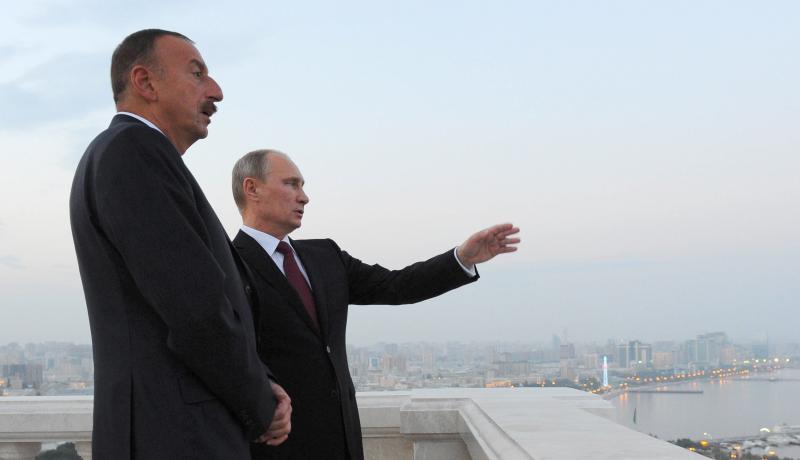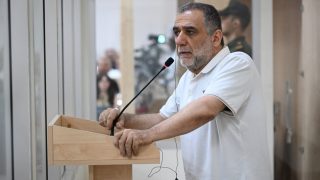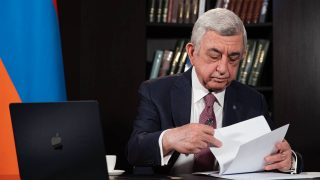After the end of the ‘four-day war’− a brief but violent outbreak of hostilities between Armenia and Azerbaijan over Nagorny Karabakh − there are muted hopes for a renewal of peace negotiations. This bodes poorly for Baku – despite Azerbaijan’s military advantage over Armenia, it has increasingly limited diplomatic choices.
Timing
Azerbaijan’s offensive was clearly the result of planning and training but it was not a blitzkrieg aimed at liberating territories under Armenian occupation – once the mission was completed, Azerbaijan announced a unilateral truce. Baku gambled on psychological factors such as a demonstration of the technological advancement of its armed forces.
The timing of escalation led to speculation that the Azerbaijani authorities used the conflict chiefly to distract the population from domestic factors – such as the country’s economic decline and corruption scandals revealed in the Panama Papers. But were this truly a factor, the offensive would likely have taken place in January, amid the regional protests against price hikes, or immediately following the revelations of the Panama Papers.
The more likely scenario is that Armenia’s declaration in February that it would pursue a deterrence strategy including the possibility of a preemptive strike became strategically problematic for Baku. Such a policy could limit Baku’s abilities along the Line of Contact.
Thus, a carefully controlled escalation served to raise international awareness of the fragility of a status quo which Azerbaijan regards as unfavourable, in order to galvanize the international mediators and put pressure on Yerevan to be constructive at the negotiating table.
In addition, the military escalation also destroyed any expectations Armenia might have harboured for support from the Russian-led Collective Security Treaty Organization (CSTO). Its response was fragmented, with Belarus, for example, openly supporting Azerbaijan’s territorial integrity.
Non-military goals
But Baku’s ultimate goal was diplomatic, to put pressure on the Armenian side. A stalemate in negotiations is unpalatable, and the military offensive helped to show Baku’s military muscle with offensive weapons of a higher technological capability than Yerevan’s. While both countries are reliant on Russian exports for conventional arming, Baku has used its larger state budget to acquire military equipment from other sources such as Israel and Turkey.
There has been a stalemate over Nagorny Karabakh since the failure of the 2011 Kazan meeting under Moscow’s auspices, which was intended to produce a framework agreement on conflict resolution. At that point, Azerbaijan offered to support the re-opening of the Turkish-Armenian border in exchange for partial liberation of territories. Previously it had opposed the normalization of Turkish-Armenian relations without full liberation as a prerequisite. At the Munich Security Conference in February 2015, Azerbaijani President Ilham Aliyev stated that ‘de-occupation of some of these districts, assuming negotiations continue, will immediately change the picture’.
The offensive has two further non-military goals. First, Baku needs to secure international investment − primarily for its gas projects, to compensate for the effect on its economy of the decline in oil prices. Baku does not have the luxury of engaging in military adventurism with the risk of a full-blown war. Meanwhile, Azerbaijan hopes that the situation will encourage potential investors to return.
The second is to consolidate army and military reform. Baku’s military budget has increased from $175 million in 2004 to $4.8 billion, which the population has thus far tolerated because of symbolic military successes. But without results in diplomatic negotiations, and with continuing troop losses, the public will turn against the government. More importantly, the effectiveness of Baku’s strategy depends not merely on deterring Armenian troops on the frontline through a war of attrition, but on the Azerbaijani army’s resolution to use its military power as a deterrent during negotiations. The reaction of Armenia is crucial; recent events could provoke a more pro-active Armenian position on Azerbaijan. Further escalation could harm the already pitifully thin modicum of trust between the two societies and their respective leaders.
The Russian factor
The short war has shone a light on Russia’s actions in the region. Moscow was previously uninterested in stopping the skirmishes. While most people in Armenia and Azerbaijan perceive Russia’s hand in the escalation, Russia’s pretense of being a mediator of the conflict has been exposed, with the unwelcome publicity that it has been selling arms to both sides.
The short war has increased the need to revive the negotiations and Russia is most likely to utilize the opportunity. Russia would like to return to the failed Kazan accords, which would entail returning five or six territories and then resolving key sticking points including the political future of Nagorny Karabakh. Russia hopes that with a resolution of the conflict, it can compel Azerbaijan into joining the CSTO and Eurasian Economic Union. This is Azerbaijan’s dilemma: submitting itself into the Russian sphere is a high price to pay, even for conflict resolution. However, in the absence of diplomatic negotiations, Baku could see increasing levels of domestic unrest. Thus, if tangible results do not come soon, more devastating military action may lie ahead.
By Zaur Shiriyev, Academy Associate
























